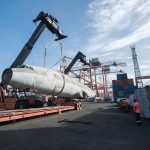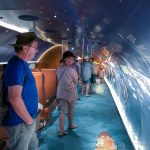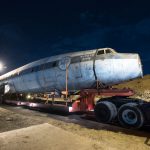For the past five years, we have been following the saga of the Qantas Founders Museum in Australia and their efforts to recover and restore a Lockheed Constellation in the livery of an original Qantas Airlines Super Constellation at their home in Longreach, Queensland. They managed to save former U.S. Navy C-121J Bu.131643 from Manila Airport in the Philippines, where it was likely about to get the axe, so the museum’s timing couldn’t have been more timely. After recovering the Constellation to Longreach, the restoration team set upon the airframe in earnest, and after much intense labor, the aircraft has reached the end of its marathon rebuild. They have created a museum space inside the aircraft rather than install bulkheads and rows of seats as would befit an airliner. While this may not be to everyone’s taste, it makes sense given the difficulty and expense of recreating a Qantas interior from the stripped-out, cargo hold.
Earlier this month, the local community got their first chance to take a look at the magnificent aircraft, and we thought our readers would enjoy reading about the event from the museum’s press release, and seeing the photographs from the restoration…
On Saturday 7 December 2019, the Longreach Community were the first to experience the new interior display of Qantas Founders Museum’s Super Constellation which will be open to the public in April 2020.
The Community Day also marked the completion of a five year project which began with the purchase of the aircraft in Manila, Philippines in September 2014.
The last stage of the project commenced in early 2019 and included the restoration of the cockpit by dedicated volunteers and the creation of the interior display by museum staff and contractors. This stage was supported by the Queensland Government’s Outback Tourism Infrastructure Fund.
The interior display explains the history and significance of the Qantas Constellations and Super Constellations from 1947 -1963. It includes the recreation of part of a passenger cabin, multimedia screens and interpretative displays.
Qantas Founders Museum CEO Tony Martin said the completion of the Super Constellation Project was an important milestone for the Museum and the display would be a valuable addition to the Museum’s collection.
“The Super Constellation Project has been a challenging and long project for our Museum but detailed planning, dedicated volunteers and contractors and ongoing support of our sponsors and the Queensland Government, has ensured this project delivered an incredible display,” said Mr Martin
“Super Constellations are not only iconic for their beautiful design but had a significant role to play in the history of Qantas and this display enables us to tell this story in a unique and memorable way. The aircraft will officially be open to the public from April 2020, just in time for the start of our Museum’s Qantas Centenary celebrations.”
Tourism Industry Development Minister Kate Jones said the Palaszczuk Government was the first in Queensland’s history to have a fund specifically dedicated to build new tourism attractions in the outback.
“We invest in projects like this to create jobs in the tourism industry in outback Queensland,” she said. “Tourists want to experience something they can’t get anywhere else.nThis project will be unique to Longreach and we know, will bring thousands of extra tourists to the outback and support local jobs.”
The restoration of the cockpit and creation of a new interior display did not come without its challenges and surprises including:
- It took volunteers 945 hours to complete the Super Constellation Cockpit. Over 400 hours were spent cleaning and preparing the cockpit’s instrument panels.
- The fuselage display took seven months to research and design and a week for a team of seven people to install.
- Planning the restoration of the cockpit proved difficult as the team of volunteers had not seen a Qantas Super Constellation cockpit in its original state and had to rely on photographs to scope the amount of work involved and materials needed.
- Before work began in the cockpit it needed to be cleaned of years of dirt, corrosion and rubbish left behind panels and in corners. Some of this rubbish included a pair of khaki men’s jocks, which probably date from the aircraft’s military time, a cap that disintegrated on retrieval and a pair of flip flops.
- The small size of the cockpit, limited the number of people who were able to work in it, made the removing of parts extremely difficult, a low ceiling was a challenge for our taller volunteers and it was a very hot work space.
- Finding cockpit instruments to replace missing ones was possible with the help of many people, networks and organisations around the world including a volunteer’s daughter-in-law bringing an instrument part from America.
- Working within the confines of a cylindrical but tapered shape of a Super Constellation fuselage was difficult especially when trying to measure for displays and interior walls as each section is slightly different to the next one.
- The shape of the fuselage meant the contractors X Squared Design had to be innovative when installing the exhibition using layered vinyl graphics and bespoke joinery specifically designed for this exhibition.
- Contractors Lightwell and X Squared Design’s interdisciplinary team were made up of exhibition designers, graphic designers, lighting, multimedia, hardware suppliers, fabricators and joiners. It was a logistical challenge to coordinate the transport of materials from Sydney and get everyone and everything onsite at the right time for install.
- All the window animations are made from Qantas Super Constellation archival material.
- Despite the display being air conditioned, the materials, hardware and media used in the display was carefully chosen for their ability to handle hot conditions in Longreach.
- Museum CEO Tony Martin – Minister Kate Jones – Longreach Mayor Ed Warren and Qantas Founders Museum Director David Fysh in front of the beautifully restored Connie during May 2019. (photo via Qantas Founders Museum)
Qantas Founders Museum’s Super Constellation:
Qantas Founders Museum purchased the Super Constellation Aircraft in September 2014 from the Manila International Airport Authority where it had been abandoned for 26 years. Over the next two and half years, the aircraft was extracted from it mud-encrusted position, disassembled and transported by ship from Manila to Townsville and by truck from Townsville to Longreach, arriving in Longreach in late May 2017. A group of volunteers and contractors then worked tirelessly in trying conditions to restore the exterior of the aircraft including replacing corroded areas, reassembling the aircraft and repainting it in the Qantas Super Constellation livery which was completed in July 2018. In 2019 the interior display and cockpit restoration was undertaken.
This aircraft was not owned or operated by Qantas but has been restored by Qantas Founders Museum to look like Qantas Super Constellation “Southern Spray” VH-EAM, to tell the important role Constellations played in the history of Qantas.
ABOUT THE QANTAS CONSTELLATIONS
The Constellation is an iconic aircraft in the history of Qantas and Australian Aviation for the following reasons:
- The Constellation operated the Qantas Kangaroo Route air services between London and Sydney from 1947.
- The Constellation was the first aircraft that enabled Qantas to establish long-range overseas air service in its own right.
- The Constellation was the first Qantas aircraft to feature flight hostesses.
- The Constellation was the first pressurised aircraft operated by Qantas.
- This was the longest air service in the world using the same aircraft all the way.
- A Super Constellation operated the first Qantas trans-Pacific air service in 1954.
- Qantas Super Constellations operated the first ever regular round-the-world air services via both hemispheres in 1958.






















































